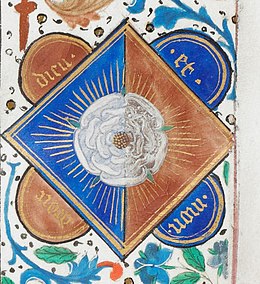White Rose of York: Difference between revisions
Rsrikanth05 (talk | contribs) m Reverted edit(s) by 81.136.161.174 identified as test/vandalism using STiki |
Svg file put in place. |
||
| Line 1: | Line 1: | ||
[[Image:Yorkshire_rose.svg|thumb|Yorkshire Rose, the [[heraldic device]] of the [[House of York]]]] |
|||
[[File:BL Royal Vincent of Beauvais2Yorkist rose.jpg|thumb|260px|White Rose of York, from a manuscript of [[Edward IV of England]]]] |
[[File:BL Royal Vincent of Beauvais2Yorkist rose.jpg|thumb|260px|White Rose of York, from a manuscript of [[Edward IV of England]]]] |
||
The '''White Rose of York''' (also called the ''Rose alba'' or '''rose argent'''), a white [[rose (heraldry)|heraldic rose]], is the symbol of the [[House of York]] and has since been adopted as a symbol of [[Yorkshire]] as a whole.<ref name="libphil">{{cite web |url=http://www.library.phila.gov/medieval/badge.htm|publisher=Free Library of Philadelphia|title=The Edward IV Roll|accessdate=2008-03-21 }}</ref> |
The '''White Rose of York''' (also called the ''Rose alba'' or '''rose argent'''), a white [[rose (heraldry)|heraldic rose]], is the symbol of the [[House of York]] and has since been adopted as a symbol of [[Yorkshire]] as a whole.<ref name="libphil">{{cite web |url=http://www.library.phila.gov/medieval/badge.htm|publisher=Free Library of Philadelphia|title=The Edward IV Roll|accessdate=2008-03-21 }}</ref> |
||
Revision as of 03:14, 16 November 2012


The White Rose of York (also called the Rose alba or rose argent), a white heraldic rose, is the symbol of the House of York and has since been adopted as a symbol of Yorkshire as a whole.[1]
History
Traditionally the origins of the emblem are said to go back to Edmund of Langley in the fourteenth century, the first Duke of York and the founder of the House of York as a cadet branch of the then ruling House of Plantagenet.[2] The actual symbolism behind the rose has religious connotations as it represents the Virgin Mary, who was often called the Mystical Rose of Heaven.[2] The Yorkist rose is white in colour, because in Christian liturgical symbolism, white is the symbol of light, typifying innocence and purity, joy and glory.[3]
During the civil wars of the fifteenth century, the White Rose was the symbol of Yorkist forces opposed to the rival House of Lancaster. The red rose of Lancaster would be a later invention used to represent the House of Lancaster, but was not in use during the actual conflict.[2] The opposition of the two roses gave the wars their name: the Wars of the Roses which was coined in the 19th century. The conflict was ended by King Henry VII of England, who symbolically united the White and Red Roses to create the Tudor Rose, symbol of the Tudor dynasty. In the late Seventeenth Century the Jacobites took up the White Rose of York as their emblem, celebrating "White Rose Day" on 10 June, the anniversary of the birth of James III and VIII in 1688.[citation needed]
At the Battle of Minden on 1 August 1759, Yorkshiremen of the King's Own Yorkshire Light Infantry's predecessor the 51st Regiment picked white roses from bushes near to the battlefields as a tribute to their fallen comrades who had died.[2] They stuck the plucked white roses in their coats as a tribute.[4] Yorkshire Day is held on this date each year.[2]
Symbol
The Yorkist rose is used in the seal of the City of York, Pennsylvania, which is known as the White Rose City.
The rose within York University crest is also a York Rose.
York's minor league baseball team that played in different leagues for several decades was called the York White Roses.
See also
References
- ^ "The Edward IV Roll". Free Library of Philadelphia. Retrieved 2008-03-21.
- ^ a b c d e "The White Rose of Yorkshire". YorkshireHistory.com. Retrieved 2008-03-21.
- ^
 "Liturgical Colours" in the 1913 Catholic Encyclopedia.
"Liturgical Colours" in the 1913 Catholic Encyclopedia.
- ^ "The Battle of Minden". HumanFlowerProject.com. Retrieved 2008-03-21.
External links



